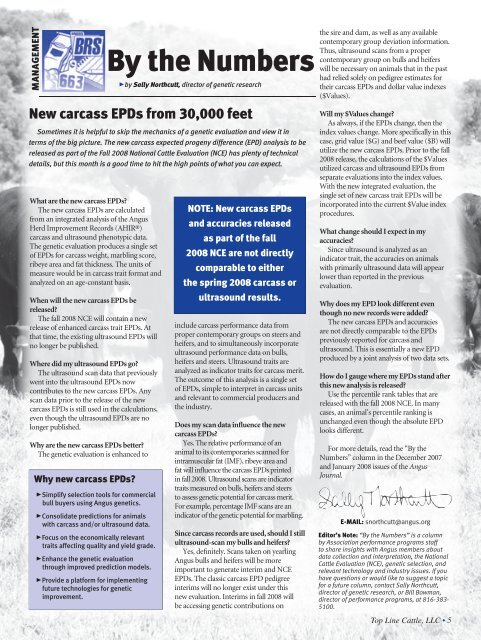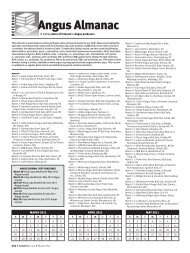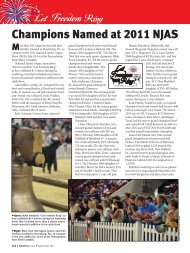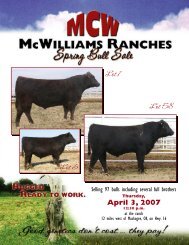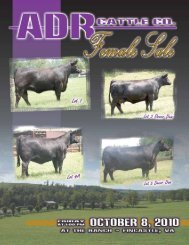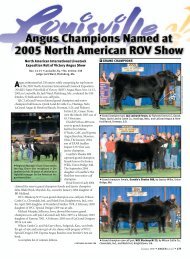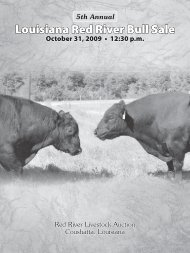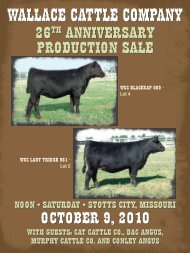Create successful ePaper yourself
Turn your PDF publications into a flip-book with our unique Google optimized e-Paper software.
maNagemeNtWhat are the new carcass EPDs?The new carcass EPDs are calculatedfrom an integrated analysis of the <strong>Angus</strong>Herd Improvement Records (AHIR®)carcass and ultrasound phenotypic data.The genetic evaluation produces a single setof EPDs for carcass weight, marbling score,ribeye area and fat thickness. The units ofmeasure would be in carcass trait format andanalyzed on an age-constant basis.When will the new carcass EPDs bereleased?The fall 2008 NCE will contain a newrelease of enhanced carcass trait EPDs. Atthat time, the existing ultrasound EPDs willno longer be published.Where did my ultrasound EPDs go?The ultrasound scan data that previouslywent into the ultrasound EPDs nowcontributes to the new carcass EPDs. Anyscan data prior to the release of the newcarcass EPDs is still used in the calculations,even though the ultrasound EPDs are nolonger published.Why are the new carcass EPDs better?The genetic evaluation is enhanced toBy the Numbers@by Sally Northcutt, director of genetic researchNew carcass ePDs from 30,000 feetSometimes it is helpful to skip the mechanics of a genetic evaluation and view it interms of the big picture. The new carcass expected progeny difference (EPD) analysis to bereleased as part of the Fall 2008 National Cattle Evaluation (NCE) has plenty of technicaldetails, but this month is a good time to hit the high points of what you can expect.Why new carcass ePDs?@Simplify selection tools for commercialbull buyers using <strong>Angus</strong> genetics.@Consolidate predictions for animalswith carcass and/or ultrasound data.@Focus on the economically relevanttraits affecting quality and yield grade.@Enhance the genetic evaluationthrough improved prediction models.@Provide a platform for implementingfuture technologies for geneticimprovement.NOte: New carcass ePDsand accuracies releasedas part of the fall2008 NCe are not directlycomparable to eitherthe spring 2008 carcass orultrasound results.include carcass performance data fromproper contemporary groups on steers andheifers, and to simultaneously incorporateultrasound performance data on bulls,heifers and steers. Ultrasound traits areanalyzed as indicator traits for carcass merit.The outcome of this analysis is a single setof EPDs, simple to interpret in carcass unitsand relevant to commercial producers andthe industry.Does my scan data influence the newcarcass EPDs?Yes. The relative performance of ananimal to its contemporaries scanned forintramuscular fat (IMF), ribeye area andfat will influence the carcass EPDs printedin fall 2008. Ultrasound scans are indicatortraits measured on bulls, heifers and steersto assess genetic potential for carcass merit.For example, percentage IMF scans are anindicator of the genetic potential for marbling.Since carcass records are used, should I stillultrasound-scan my bulls and heifers?Yes, definitely. Scans taken on yearling<strong>Angus</strong> bulls and heifers will be moreimportant to generate interim and NCEEPDs. The classic carcass EPD pedigreeinterims will no longer exist under thisnew evaluation. Interims in fall 2008 willbe accessing genetic contributions onthe sire and dam, as well as any availablecontemporary group deviation information.Thus, ultrasound scans from a propercontemporary group on bulls and heiferswill be necessary on animals that in the pasthad relied solely on pedigree estimates fortheir carcass EPDs and dollar value indexes($Values).Will my $Values change?As always, if the EPDs change, then theindex values change. More specifically in thiscase, grid value ($G) and beef value ($B) willutilize the new carcass EPDs. Prior to the fall2008 release, the calculations of the $Valuesutilized carcass and ultrasound EPDs fromseparate evaluations into the index values.With the new integrated evaluation, thesingle set of new carcass trait EPDs will beincorporated into the current $Value indexprocedures.What change should I expect in myaccuracies?Since ultrasound is analyzed as anindicator trait, the accuracies on animalswith primarily ultrasound data will appearlower than reported in the previousevaluation.Why does my EPD look different eventhough no new records were added?The new carcass EPDs and accuraciesare not directly comparable to the EPDspreviously reported for carcass andultrasound. This is essentially a new EPDproduced by a joint analysis of two data sets.How do I gauge where my EPDs stand afterthis new analysis is released?Use the percentile rank tables that arereleased with the fall 2008 NCE. In manycases, an animal’s percentile ranking isunchanged even though the absolute EPDlooks different.For more details, read the “By theNumbers” column in the December 2007and January 2008 issues of the <strong>Angus</strong><strong>Journal</strong>.e-mail: snorthcutt@angus.orgeditor’s Note: “By the Numbers” is a columnby Association performance programs staffto share insights with <strong>Angus</strong> members aboutdata collection and interpretation, the NationalCattle Evaluation (NCE), genetic selection, andrelevant technology and industry issues. If youhave questions or would like to suggest a topicfor a future column, contact Sally Northcutt,director of genetic research, or Bill Bowman,director of performance programs, at 816-383-5100.Top Line Cattle, <strong>LLC</strong> • 5


